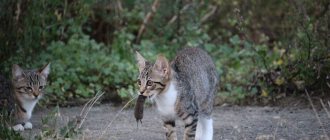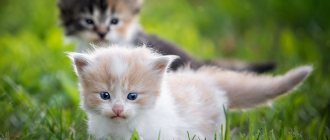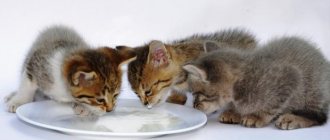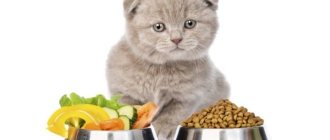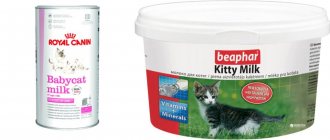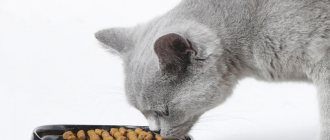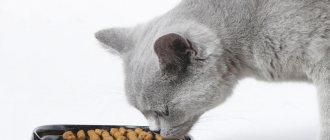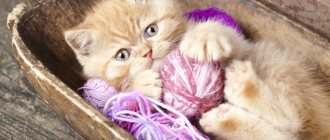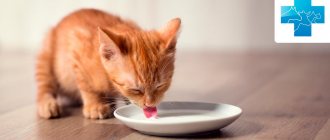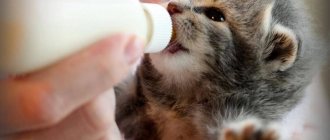After breastfeeding ends, the responsibility for feeding the furry pet is transferred to the owner. For full growth and development, a kitten requires not only nutrients, but also vitamins to strengthen the bone structure. Any mistake is fraught with health problems and even the death of a fragile pet. The owner will have to understand the nuances of different types of nutrition, recommended modes and portion sizes.
Nutritional features of a two-month-old kitten
The first complementary foods are given after 4 weeks, when the first teeth begin to emerge. The diet can be based on dry or natural food, depending on the characteristics of the pet and the wishes of the owner.
By breed
All cats are carnivores, so their diet should include meat and sufficient protein. Veterinarians recommend starting from life in the wild. A fishing cat is a rare occurrence, but milking a cow independently is a completely phenomenal case. Therefore, fish and dairy products are not as necessary for cats as poultry or animal meat.
There is no strict division by breed. The feeding rules are the same for everyone, but can be adjusted depending on the breed characteristics:
- Maine Coons
. "Manx raccoons" are distinguished by their large dimensions. They require much more food than other breeds. Maine Coons have a hard time digesting food, so they are fed small but frequent portions. With this approach, the stomach does not have time to be overloaded, and the body receives the necessary energy.
- British and Scots
. Thick-cheeked and lop-eared handsome men are prone to obesity. These short-haired pets need to be fed high-protein, low-carbohydrate meals. If your weight jumps above normal, it is recommended to reduce calorie intake by reducing portions or replacing foods.
- Sphinxes
. Hairless cats are voracious and always hungry, but are less likely to gain weight. Most of what they eat goes to warm their naked body. Babies up to 4 months are fed 6 times a day, gradually moving to 2 meals a day by 1 year. The daily intake for an adult cat is 5% of its weight.
It is recommended that you check with the breeder or veterinarian for nutritional details regarding the selected breed. Don't forget to monitor your weight and reaction to new foods. This will help avoid secondary diseases arising from obesity and aggravation of food allergies.
By frequency of meals
Some cats are born without a sense of satiety. Focusing on a hungry gaze is pointless and dangerous. Such animals eat until they vomit and quickly gain weight, suffering from diseases of the musculoskeletal system, urolithiasis and other pathologies.
To prevent unpleasant consequences, use a strict regimen that takes into account the frequency of meals and the amount of food for different ages. It is best to discuss recommendations regarding serving sizes with your veterinarian. This depends on the breed and growth rate, so the indicator is calculated individually.
Up to 1 month, food is offered not only during the day, but also at night. Feeding a kitten at 2 months already excludes night hours - it is enough to serve food 6-7 times during the day. Animals older than 1 year are fed twice.
By diet composition
A two-month-old pet has all its milk teeth, so its diet is enriched with more solid food. Puree-like meat, ground with vegetables, is replaced with small boiled pieces. Continue cooking the grains until they become watery, providing enough liquid.
When offering new dishes, monitor your baby's reaction. The appearance of diarrhea, vomiting, rashes and other alarming signs is a serious reason to exclude certain foods. Also start from the taste of your furry pet. Do not allow prolonged fasting - if you refuse the offered dishes, always look for alternative ones.
Transition from mother's milk to solid foods
If your baby is left without breast milk before reaching two months of age, take care of him yourself. As a safe replacement, veterinarians recommend using powdered milk formulas sold in pet stores and veterinary pharmacies. Homemade mixtures, including cow's milk, granulated sugar, yeast and egg, are acceptable only as a temporary option. They are inferior to ready-made mixtures due to their lower nutritional value and highly allergenic properties.
The transition to solid food begins at 1 month. You can feed your pet:
- liquid porridges (semolina, rice);
- light meat broths without salt;
- finely chopped boiled lean meat;
- natural fermented milk products with low fat content.
1-2 times a week, offer boiled egg yolk or boiled sea fish, cleaned of bones. Introduce the listed products gradually and monitor the body’s reaction.
During feedings, make sure that your little pet does not fall into the food bowl. Left alone, he may choke.
Feeding a 2 month old kitten
The feeding of the kitten will determine its future life, character and behavior. At first, it is necessary to monitor how the cat eats, since sometimes pets may refuse certain foods. In this case, you should change your diet and add new foods. For a growing body, it is important that food is filled with vitamins and microelements.
First of all, it is necessary to choose a food that will replace the baby’s mother’s milk and strengthen the immune system.
For your information! It is not always possible to get a kitten to eat new food the first time; they can squeak and resist, looking for the mother cat's breast.
Menu for a kitten
There are three nutrition options for growing kittens:
- natural food;
- prepared feed;
- mixed type.
Even a veterinarian cannot say which of the above options is the most optimal. Experts are divided on the diet of small pets, so some advocate natural products, while others believe that a mixed type is suitable.
You need to choose what to feed a two-month-old kitten based on your own financial capabilities, breed, free time and preferences of the baby.
How many times a day to feed
Kittens are usually given their first complementary food at the age of 1 month. It is necessary to plan further nutrition from then on. How many times the feeding will be done depends on the age of the pet. A young body should eat food 5 to 7 times a day. During periods of active growth, pets may ask for food even more often. Therefore, it is necessary to focus on the individual characteristics of the baby, his condition and activity.
Depending on the age, the amount of food a pet should eat also changes.
Two month old kittens need 150-190 g of food per day
Menu made from natural ingredients
Supporters of “natural food” emphasize its naturalness and safety for the cat’s body. Despite this statement, natural products have their drawbacks: not all of them are equally healthy and harmless.
Advantages and disadvantages
The main advantage is the ability to independently select ingredients. This eliminates the presence of artificial colors and preservatives. Also among the advantages it is worth noting:
- menu variety;
- the ability to replace one dish with another without harm to the body;
- absence of dependence and addiction.
The disadvantages of “natural” food lie in the difficulty of regularly preparing fresh dishes and complying with the recommended consumption of vitamin and mineral complexes. Such food requires a lot of free time and is sometimes more expensive than dry food.
Required Products
The diet is based on meat, offal, dairy products, cereals and vegetables. Due to the danger of infection by parasites, offal is given only in boiled form twice a week. I also boil chicken breast, turkey, veal or other lean meats, and 60% of the diet should come from protein products.
Once a week, the meat is replaced with sea fish, cleaned of bones. It is enriched with phosphorus, which improves wool quality. Eating fish too often can lead to loss of vitamin K and the development of urolithiasis due to excess protein.
Prepare healthy dishes based on grated zucchini, beets, carrots and herbs, adding small pieces of meat to them. Offer 1 teaspoon three to four times a week. vegetable oil from olive or flax. Once a week, add the boiled yolk of a chicken or quail egg to the porridge - it normalizes digestion.
Natural cottage cheese and low-fat sour cream are available sources of calcium. They strengthen bones and saturate the body with vitamins.
Prohibited Products
Another disadvantage of “natural” is the presence of prohibited products. These include:
- bones that can damage the esophagus or block the supply of oxygen;
- fatty meat and lard that overload the liver;
- mushrooms, eggplants, garlic, legumes, potatoes, tomatoes and onions;
- any seasonings;
- raw egg whites and chicken skin;
- whole milk, which causes digestive problems due to lactose intolerance;
- canned, smoked, fried or other dishes from the human table;
- sweets and baked goods considered toxic to animals;
- river fish containing the most dangerous parasites.
Lactose problems are more common in older animals, but sometimes occur earlier. Observe the kitten after he has treated himself to milk.
How to choose a diet? What are the consequences of poor nutrition?
Having decided on the age, it’s time to find out what to feed your kitten at 2 months. First of all, for a growing body it is necessary that food be rich in vitamins and microelements. Without them, the animal will develop incorrectly - vision may be impaired, bones and claws may grow abnormally, and general health will deteriorate.
How to decide what tastes better?
Poor nutrition significantly increases the risk of abnormal development of the baby
In particular, a two-month-old kitten must necessarily and regularly receive vitamin A. In moderation, it is important for growth and cell renewal, and has a beneficial effect on the condition of the skin and vision. A lack of vitamin A can be identified by watery eyes, digestive problems and difficulty breathing.
B vitamins also play an important role in maintaining the health of the body.
- B1 is important for proper digestion of food and normal metabolism. Participates in the breakdown of carbohydrates and gives the animal energy;
- B2 - necessary for weight gain and soft, healthy coat;
- B5 - for kidney function, healthy skin and coat. Without it, dermatitis will appear, and hair will fall out during shedding;
- B6 - needed for the absorption of food, in particular proteins, to eliminate cramps;
- B12 - with its participation the pet’s liver and nervous system work.
With their deficiency, general weakness, poor digestion of food, hair loss, weight loss, and problems with the musculoskeletal system are observed.
Vitamin D helps the absorption of calcium, is responsible for the absence of rickets, normal growth of bones, teeth and claws. The first indicator of a lack of this vitamin is poor growth of the cat.
Vitamin E is an antioxidant that fights off free radicals entering the kitten's body. Participates in the puberty of the pet.
Vitamin K is needed for good blood clotting.
There are 3 feeding options for kittens. Let's get to know them in more detail and choose the most optimal one.
Natural nutrition
The main advantage with this type of feeding is that you know exactly what you are feeding your two-month-old kitten. True, there are more problems here: it takes time to prepare food, and there is a risk of parasite infection through insufficiently processed foods.
Do not confuse natural feeding with simple homemade food - you cannot feed your pet from your table
The diet of a growing organism requires foods containing protein (meat, fish, eggs), fats (egg whites, offal, butter) and carbohydrates (cereals like oatmeal, buckwheat, rice, millet). When cooking meat, poultry and fish, it is better to boil or steam them. Fried and baked foods contain excess fat. Spices and sugar can cause diseases, and only iodized salt is recommended (no more than half a teaspoon per kilogram of meat).
Meat is an integral product in a natural diet
You can diversify the menu with low-fat fermented milk products, low-fat cottage cheese (can be for children), fresh or boiled vegetables, boneless sea fish, sprouted grass (wheat sprouts and oats). To make it easier for your baby to go to the toilet, give half a teaspoon of vegetable oil every three days.
It is advisable to chop the cooked food into small pieces, or even better, put it through a blender. To avoid cooking for your cat every day, the food can be divided into portions and frozen. Before serving, you should warm the food to room temperature.
Ready-made feed
If you don’t have the time or desire to think through a menu for your pet, then you can turn to store-bought options. Ready-made food (both dry and wet) is balanced in composition and contains everything that the growing animal’s body needs.
If you often leave and other people are looking after the baby, then it is better to feed the kitten with ready-made food all the time
It must be admitted that choosing a truly worthwhile product from all the existing variety is not easy. Among the universal recommendations, the following can be highlighted: give preference to premium brands of food. In their production, high-quality raw materials are used, which ensures their high nutritional value. Experts advise avoiding economy class, and this is also true for adults.
Veterinarians advise buying age-appropriate food only in veterinary pharmacies and pet stores. Do not ignore the dosage recommendations on the package. It is not advisable to mix dry and wet food: they have different digestion times and it will be difficult for the body to adjust.
Dry food stimulates jaw development, but has a significant disadvantage - it can be addictive
The introduction of new feeds or the transition from dry to wet (and vice versa) should be smooth. The first time you should give it a little, with constant monitoring of the pet’s reaction.
Combined nutrition
There is no consensus on the acceptability of this type of feeding. Some experts are categorically against it, predicting digestive problems for the baby and the risk of developing hypervitaminosis. Others see this as an ideal balance - the kitten eats natural food, and receives the missing substances from ready-made food, which eliminates the need to buy additional vitamin and mineral supplements.
Consider the digestion time of various foods and feeds so as not to harm your baby’s stomach.
To some extent, you can agree with each of the statements. To resolve the dilemma, seek advice from a veterinarian: he will give you accurate recommendations based on the results of an individual examination of the pet.
Dry and wet food
In addition to classic dry food, you can use wet canned food. Together they compensate for each other's shortcomings: 75% of the diet is allocated to dry food, and 25% to wet food. This also has its own nuances, so before deciding what food to feed a 2-month-old kitten, compare the advantages and disadvantages of each method.
Advantages and disadvantages
Most of the disadvantages lie in low-quality economy class products. It is prepared from low-quality raw materials (bones, fats, skins, feathers) with an abundance of mineral salts, preservatives and flavorings. These ingredients have a detrimental effect on the cat’s body, provoking the development of urolithiasis.
If an allergy or other disease occurs that requires a change in food, it takes quite a long time (8-10 days) to mix new granules with the old ones in order to make a smooth transition. Abrupt transitions are excluded, as they can provoke gastrointestinal upset.
Safe and healthy products include premium, super-premium and holistic classes. Their advantages are:
- an abundance of different lines developed for individual breeds, as well as taking into account age characteristics and the presence of diseases;
- saving time on cooking;
- availability of daily allowances on each package;
- balance of composition;
- prevention of tartar and strengthening of the jaw muscles.
Dry granules take up little space, making them easier to take when traveling. It is easier to leave an animal with this type of food for foster care with relatives or friends. Even an elderly person with limited mobility can feed your pet.
Variety of food for kittens
When purchasing a furry family member through a breeder, check in advance what to feed your two-month-old baby. If the seller has already started feeding him a specific brand, then stick to the same brand for up to a year.
The most expensive granules and wet canned food belong to the holistic class. Despite their prestige, they are not suitable for animals with problems with the urinary system.
The best brands of kibble and canned food that have a line for kittens include:
- Hill's;
- Orijen;
- Happy Cat Junior;
- 1st Choice;
- Eukanuba;
- Royal Canin;
- ProNature;
- Purina ProPlan;
- Acana;
- Go Natural.
Wet canned food is served to your pet only when heated. Be sure to put any uneaten pieces in the refrigerator until the next feeding.
How to choose?
Avoid stores that sell pellets by weight. Once the package is opened, the shelf life is reduced. The quality of such a product is often questionable.
When choosing a brand, consider the manufacturer. Products from Russian factories are significantly inferior in quality. The safest producing country is Canada. Some Canadian food can even be eaten by humans.
Be sure to consult your veterinarian before purchasing. If there are diseases, he will offer a veterinary line.
Remember that you cannot save on ready-made food; eating budget brands will lead to the same problems as eating fast food.
Norms of growth and development of kittens at 2 months
Let's look at the features of 2-month-old cats
According to average indicators at this age, the pet’s weight ranges from 750 to 1,200 grams. If you have a purebred kitten, then the parameters here are clearer. For example, the normal weight of Bengal cats at 2 months is 500-1,000 g, Abyssinian cats - 750-1,000 g, Maine Coons - 1,100 - 1,500 g, and the largest spread among the British is 450-1,700 g.
In terms of size, kittens that are 2 months old are already quite large, with well-fed paws and a less protruding tummy than that of very tiny ones. But perhaps the most reliable indicator of an animal’s age is its teeth. By 8 weeks, kittens have a full set of baby teeth - 26. They can already eat only solid food and are practically independent of the cat's milk.
The habit of suckling mother's milk calms babies and can last up to six months
Closer to two months of life, you can understand from small four-legged pets what they will be like in adulthood: playful, affectionate, or wild and withdrawn. From this period, they begin to more actively study the world around them, trying to run away from their mother cat. Often they try to climb higher, but cannot go down yet. Such kittens need to be monitored more closely, because if they fall down, the kids can get serious injuries.
Mixed nutrition
The owner will have to decide in advance what to feed the kitten at 2 months and adhere to the chosen type of food. It is not recommended to mix both types of feeding: it is forbidden to give the kitten dry food in the morning, and meat and porridge in the evening. This can lead to an excess of vitamins or pathologies of the gastrointestinal tract (gastroenteritis, intestinal obstruction).
If the owner needs to transfer the baby from one type of feeding to another, it is necessary to make the transition as smooth as possible. In the case of a two-month-old kitten, it is better to consult a veterinarian - at least by phone.
How to feed a kitten at two months
There are simple rules for feeding a two-month-old pet:
- The daily portion of natural food is not given immediately, the baby does not yet control his appetite. Dry food can be poured in immediately;
- all food should be warm. If the food was in the refrigerator, it is heated;
- cooked food should not be stored in the refrigerator for longer than 24 hours;
- wet prepared food is stored open for no more than two days;
- if the food is natural, vitamins for cats are added to it;
- There is water in a separate bowl. The bowl should be freely accessible, and the water should always be clean and fresh.
It will not be difficult for a responsible person to follow all the nutritional rules for a kitten, and the pet will grow up strong and healthy.
Feeding regimen and portion size
Two-month-old kittens are fed 6 times a day. The baby should eat 160-180 g of natural products per day. Standards for dry granules, taking into account the weight of the animal, are indicated on the packaging.
Divide your daily intake into 6 equal portions or make 3 smaller portions and use them as snacks. Until six months, the pet is actively developing, gaining muscle mass. It is important to maintain a balance here: avoid overfeeding or starvation. Weigh your baby weekly to monitor changes in his weight.
Approximate diet, norms and frequency
Experts recommend leaving at least 50% of the diet for proteins, 10-15% for carbohydrates and the rest for fats. To create a daily menu for a cat, you need to calculate the calorie content and determine the number of meals. How many times should I feed a 2 month old kitten? There is no exact answer to this question, but all experts agree that cats from 2 to 3 months need no more than 7 feedings per day.
It is necessary to adhere to the golden mean - you should not overfeed your pet, but starvation will definitely not bring any benefit to a growing body.
The calorie content of the diet for cats is calculated using the formula:
K*(30*m + 70), where m is the weight of the cat in kg, and K is the multiplier (in our case it is equal to 1.2).
Cats have different taste preferences: to determine your baby's favorite foods, you will have to experiment
Having selected suitable foods for your cat, look at their calorie content and calculate how many grams of such food can be given to the cat. The calorie content of foods popular with cats is shown in the table.
| Product | Calorie content | Squirrels | Fats | Carbohydrates |
| Chicken fillet | 110 | 23 | 1.2 | 0 |
| Chicken drumstick | 198 | 18 | 14 | 0 |
| Lean beef | 158 | 22.2 | 7.1 | 0 |
| Salmon | 142 | 19.8 | 6.3 | 0 |
| Cod | 78 | 17.7 | 0.7 | 0 |
| Chicken egg | 157 | 12.7 | 10.9 | 0.7 |
| Cottage cheese 5% | 121 | 17.2 | 5.0 | 1.8 |
| Buckwheat | 313 | 12.6 | 3.3 | 62.1 |
| Cereals | 366 | 11.9 | 7.2 | 69.3 |
| Carrot | 32 | 1.3 | 0.1 | 6.9 |
If the animal’s diet consists of ready-made food, then the owner does not need to independently calculate the dosage - it is indicated on the product packaging
General rules
For the full development of a little pet, the owner will have to follow a number of rules. These include:
- Use only fresh and warm food. Do not store food for more than a day and be sure to warm it to room temperature before serving. The shelf life of wet canned food should not exceed 2 days.
- Mandatory division of the daily norm into several doses. Don't try to offer everything at once and put the bowl away after finishing feeding.
- Regular washing of dishes. Pathogenic microorganisms grow quickly in food bowls. Wash them after each feeding and try to use ceramic or iron products.
- A ban on any methods of heat treatment of food other than boiling.
Additional attention will have to be paid to the drinking regime and vitamins. It is best to discuss the last question with your veterinarian.
Do I need additional vitamins?
Ready-made food already contains all the necessary vitamins, so only those who eat natural food will need additional supplements. A growing body needs vitamins A, B, C, D, E and K, as well as minerals (calcium, iron, phosphorus, magnesium, selenium). Their deficiency is fraught with weak immunity, deterioration of the coat, softening of bones and teeth, impaired blood clotting and other complications.
It is important to consider the danger of not only a lack, but also an excess of vitamins. Independent selection of vitamin and mineral complexes can lead to hypervitaminosis. The brand name, dosage and duration of use should be checked with your veterinarian. The most commonly prescribed are Gimpet, Excel, Canina and Hartz.
Drinking regime
As you transition to solid foods, you will need more liquid, so purchase a separate bowl for water. Do not pour it from the tap without first cleaning it. Sediments contained in tap water are dangerous for your little pet. Also, do not forget about hygiene - wash the bowl and change the water in it daily.
If your pet eats dry granules, pay special attention to the drinking regime. Lack of fluid provokes salt deposition, which can lead to the formation of stones and blockage of the urinary ducts. If your water consumption is low, give it from a syringe or experiment with containers. Most picky cats will accept the owner's mug, large bucket-like container, or drinking fountain.
Proper and balanced nutrition is the basis of strong immunity and health. Compliance with the listed nuances and recommendations will protect your pet from a number of diseases and allow him to grow into an attractive cat.
The article is for informational purposes only. Contact your veterinarian!
Do you like the article? 155
How to determine if a diet is suitable for your pet
You can accurately understand whether you are doing everything correctly by watching your baby. It should be understood that negative reactions may not appear immediately, so remain vigilant for several weeks after introducing the food. If a certain product is poorly digested, the kitten may be allergic to it or the pet may simply not like it.
If there are allergies or physiological problems, the food should be replaced with another one.
A well-chosen diet ensures the baby has a healthy appearance and mobility, the pet eats with appetite and gets enough food, and the kitten has no digestive problems (flatulence, diarrhea or constipation, vomiting, colic).
Milk for kittens - benefits and harm
Milk is undoubtedly a product rich in beneficial components. These are fatty acids, animal proteins and various microelements. They are sources of energy, and most of the components in its composition are building materials for new cells.
Milk has many benefits, but it can also have a negative impact on a kitten's health. Disadvantages of eating milk:
- indigestion;
- imbalance of proteins, fats and carbohydrates;
- the danger of sand and stones forming in the cat’s bladder;
- risk of developing an allergic reaction to milk.
Many veterinarians agree that milk is completely useless for adult cats, since its components are practically not absorbed by their bodies.
Milk contains many useful substances, but it can be dangerous for a kitten
Can I give it to a kitten - food table
| Product | Can I give it to a kitten? |
| Banana | No |
| Borsch | No |
| Broccoli | Yes |
| Buckwheat | Yes |
| Baby food | Yes |
| Potato | No |
| Kefir | Yes |
| Food for adult cats | No |
| Semolina | No |
| Milk | No |
| Carrot | Yes |
| Oatmeal | Yes |
| Cucumber | Yes |
| Liver | Yes |
| Tomato | Yes |
| Rice | Yes |
| Fish | No |
| Ryazhenka | Yes |
| Sour cream | No |
| Soup | Yes |
| Raw meat | Yes |
| Cottage cheese | Yes |
| Grass | No |
| ground meat | Yes |
| Bread | No |
| Chocolate | No |
| Apple | Yes |
| Egg | Yes |
Is plant milk suitable for a kitten?
Owners of kittens who support a vegetarian diet are wondering whether their kittens can be given plant-based milks.
Almond milk is made from a mixture of ground, unroasted almonds and water. There is no lactose in this milk. But almonds are toxic to cats.
Soy milk also does not contain lactose. But soy is very difficult for the delicate cat’s body to digest, since the kitten’s body does not have enzymes to process it. Even if your pet drinks soy milk, there will be no benefit from it.
Coconut milk is obtained by squeezing coconut pulp. Due to the high fat content of coconut milk, it is not only not healthy for the kitten, but in large quantities it is very harmful and leads to excess weight gain.
Cats are carnivores by nature, which makes it difficult for them to absorb plant-based substances. Therefore, you should not experiment with your pet’s nutrition. All a kitten needs is ordinary clean water. It is needed for the development of the cat’s body and promotes better absorption of food.
Kittens do not digest plant milk well
Are sheep and goats allowed?
Goat's milk is easier to digest and is absorbed very quickly by the kitten's body. It should also be noted that it contains vitamins A, B1 and B2. The proteins contained in such milk are much less likely to cause intolerance in kittens. Goat's milk is better in composition than cow's milk. In addition, it is low-allergenic. Sheep milk is very similar in properties to goat milk.
Don't forget that store-bought cow's milk usually has reduced fat content, while goat's or sheep's milk is most often sold with natural fat content.
Thus, the question of whether it is possible to give a kitten goat’s milk can be answered positively, but it is advisable to dilute it with a small amount of water.
Goat's milk is much healthier for a kitten than cow's milk
Milk replacers for kittens
The only complete replacement for cat milk is a specialized dry formula, which is sold in veterinary pharmacies.
The cat's milk replacer must be quite high in calories to ensure rapid and regular weight gain for the kitten.
When purchasing such a mixture, you should pay attention to the fat content of the product. It should be at least 8-8.5%. The mixture should be enriched with taurine, Omega-3 and Omega-6 fatty acids, without which developmental pathologies are possible.
Cat milk replacers are similar in composition to mother cat milk
Lactose intolerance in kittens - signs
Lactose or milk sugar is found only in milk.
Symptoms of lactose intolerance become apparent approximately 8-12 hours after the kitten drinks the milk. Intolerance manifests itself in the form of diarrhea, vomiting and bloating.
This happens due to the inability of the kitten’s body to process lactose, which passes through the intestines unchanged. By attracting water, it moves further and in the large intestine it meets bacteria that try to process it. This is accompanied by the release of hydrogen, carbon dioxide and a number of other substances, causing fermentation in the kitten’s body.
Lactose is found only in milk
